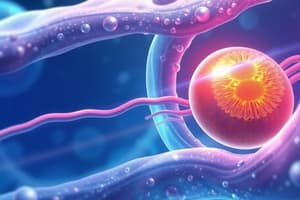Podcast
Questions and Answers
Which transport mechanism requires energy to move substances against their concentration gradient?
Which transport mechanism requires energy to move substances against their concentration gradient?
- Facilitated Diffusion
- Active Transport (correct)
- Passive Transport
- Osmosis
What is the primary role of cholesterol in the cell membrane?
What is the primary role of cholesterol in the cell membrane?
- To maintain membrane fluidity and stability (correct)
- To form glycoproteins
- To facilitate simple diffusion
- To assist in cell signaling
What describes the structure of the cell membrane according to the fluid mosaic model?
What describes the structure of the cell membrane according to the fluid mosaic model?
- A dynamic and flexible structure with various embedded proteins (correct)
- A solid layer with uniform distribution of proteins
- A static structure that does not change shape
- A rigid layer composed exclusively of lipids
Which type of protein spans the entire membrane and is mainly involved in transport?
Which type of protein spans the entire membrane and is mainly involved in transport?
Which process involves the uptake of large particles by the cell?
Which process involves the uptake of large particles by the cell?
Which type of transport does the sodium-potassium pump demonstrate?
Which type of transport does the sodium-potassium pump demonstrate?
Which type of membrane transport uses transport proteins and does not require energy?
Which type of membrane transport uses transport proteins and does not require energy?
How do carbohydrates contribute to the cell membrane's function?
How do carbohydrates contribute to the cell membrane's function?
Which function is NOT performed by membrane proteins?
Which function is NOT performed by membrane proteins?
What initiates a cellular response in signal transduction?
What initiates a cellular response in signal transduction?
Which type of receptor is primarily involved in activating phosphorylation cascades?
Which type of receptor is primarily involved in activating phosphorylation cascades?
Which secondary messenger is commonly involved in signal transduction pathways?
Which secondary messenger is commonly involved in signal transduction pathways?
What is the primary role of glycoproteins in cell membranes?
What is the primary role of glycoproteins in cell membranes?
What is a function of G-protein Coupled Receptors?
What is a function of G-protein Coupled Receptors?
Flashcards are hidden until you start studying
Study Notes
Cell Membrane Study Notes
Membrane Transport Mechanisms
-
Passive Transport: Movement of molecules without energy input.
- Diffusion: Movement from high to low concentration.
- Facilitated Diffusion: Uses transport proteins for molecules that cannot directly cross the membrane.
- Osmosis: Diffusion of water through a selectively permeable membrane.
-
Active Transport: Requires energy (ATP) to move substances against their concentration gradient.
- Primary Active Transport: Directly uses ATP (e.g., Sodium-Potassium pump).
- Secondary Active Transport: Uses the energy from the movement of one molecule to drive another molecule against its gradient (cotransport).
-
Vesicular Transport: Involves the formation of vesicles to transport larger molecules.
- Endocytosis: Process of taking materials into the cell.
- Phagocytosis: "Cell eating"; uptake of large particles.
- Pinocytosis: "Cell drinking"; uptake of fluids and small solutes.
- Exocytosis: Release of materials from the cell.
- Endocytosis: Process of taking materials into the cell.
Structure and Composition
- Phospholipid Bilayer: Basic structure comprising hydrophilic heads and hydrophobic tails.
- Cholesterol: Interspersed among phospholipids; maintains fluidity and stability.
- Proteins: Integral and peripheral proteins perform various functions.
- Carbohydrates: Attached to proteins and lipids, forming glycoproteins and glycolipids; involved in cell recognition.
Fluid Mosaic Model
- Describes the cell membrane as a dynamic and flexible structure.
- Fluidity: Lipids and proteins can move laterally within the layer, allowing for flexibility and adaptability.
- Mosaic: Membrane is composed of various proteins that float in or on the fluid lipid bilayer.
Membrane Proteins
- Integral Proteins: Span the membrane; involved in transport and communication.
- Peripheral Proteins: Loosely attached to the membrane surface; play roles in signaling and maintaining cell shape.
- Functions:
- Transport: Channels and carriers facilitate molecule movement.
- Enzymatic Activity: Catalyze reactions on the membrane surface.
- Signal Transduction: Receive and transmit signals from outside to inside the cell.
- Cell Recognition: Glycoproteins serve as markers for cell identity.
Cell Signaling
- Involves communication between cells through signaling molecules (ligands).
- Receptors: Proteins on the cell membrane that bind to ligands, initiating a response.
- Types of Receptors:
- G-protein Coupled Receptors (GPCRs): Activate intracellular signaling pathways upon ligand binding.
- Tyrosine Kinase Receptors: Trigger phosphorylation cascades affecting cellular responses.
- Types of Receptors:
- Signal Transduction Pathways: Series of molecular events that lead to a cellular response; often involve secondary messengers (e.g., cAMP, calcium ions).
- Cellular Responses: Can include changes in gene expression, cellular metabolism, and cell behavior (growth, apoptosis).
Membrane Transport Mechanisms
- Passive Transport: Movement of substances across membranes without energy; relies on concentration gradients.
- Diffusion: Natural movement of molecules from an area of high concentration to low concentration.
- Facilitated Diffusion: Utilizes specific transport proteins to aid the movement of large or polar molecules across the membrane.
- Osmosis: Movement of water molecules through a selectively permeable membrane, balancing solute concentrations.
- Active Transport: Energy-requiring process (ATP) that moves substances against their concentration gradient.
- Primary Active Transport: Direct use of ATP, exemplified by the Sodium-Potassium pump, crucial for maintaining cellular ion balances.
- Secondary Active Transport: Utilizes energy derived from the transport of one substance to drive the transport of another (e.g., glucose coupled to Na+ transport).
- Vesicular Transport: Mechanism for moving large quantities of materials in and out of cells via vesicles.
- Endocytosis: Cellular uptake process for materials; includes recognition and engulfment of substances.
- Phagocytosis: A type of endocytosis that involves the ingestion of large particles or cells.
- Pinocytosis: A form of endocytosis that involves the uptake of liquid and small solute molecules.
- Exocytosis: Process for expelling materials from the cell, crucial for secretion functions.
Structure and Composition
- Phospholipid Bilayer: Fundamental structure, consisting of hydrophilic heads facing outward and hydrophobic tails facing inward, creating a barrier to water-soluble substances.
- Cholesterol: Embedded within the bilayer, plays a critical role in maintaining membrane fluidity and structural integrity.
- Proteins: Divided into integral (spanning the membrane) and peripheral (attached to the surface) proteins, each fulfilling distinct roles in functionality.
- Carbohydrates: Associated with proteins and lipids to form glycoproteins and glycolipids, essential for cell recognition and signaling.
Fluid Mosaic Model
- Describes the cell membrane's structure as a flexible and dynamic assembly of various proteins and lipids.
- Fluidity: Allows lateral movement of lipids and proteins, promoting flexibility and adaptability to cellular environments.
- Mosaic Nature: Highlights the diversity of membrane proteins that float within or on the lipid bilayer, contributing to varied functions.
Membrane Proteins
- Integral Proteins: Span the lipid bilayer and are critical for transport processes and cellular communication.
- Peripheral Proteins: Associate loosely with the surface; involved in signaling pathways and structural support.
- Functions:
- Transport: Channels and carrier proteins allow selective passage of molecules.
- Enzymatic Activity: Certain proteins catalyze reactions directly at the membrane surface, enhancing metabolic processes.
- Signal Transduction: Proteins receive extracellular signals and transmit them into the cell, initiating responses.
- Cell Recognition: Glycoproteins participate in identifying and differentiating cell types.
Cell Signaling
- Communication: Involves the release and reception of signaling molecules known as ligands.
- Receptors: Membrane proteins responsible for binding ligands, causing a conformational change leading to a cellular response.
- Types of Receptors:
- G-protein Coupled Receptors (GPCRs): Trigger intracellular signaling when ligands bind, activating G-proteins for diverse messaging pathways.
- Tyrosine Kinase Receptors: Involved in phosphorylation cascades that drive cellular responses to growth signals.
- Signal Transduction Pathways: Series of molecular processes, including the involvement of secondary messengers (e.g., cAMP, calcium ions), leading to a specific cellular activity.
- Cellular Responses: Outcomes may include alterations in gene expression, metabolic activity, and changes in cellular behavior such as growth or programmed cell death (apoptosis).
Studying That Suits You
Use AI to generate personalized quizzes and flashcards to suit your learning preferences.





